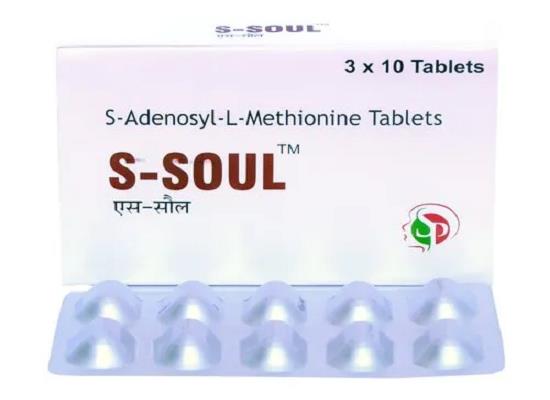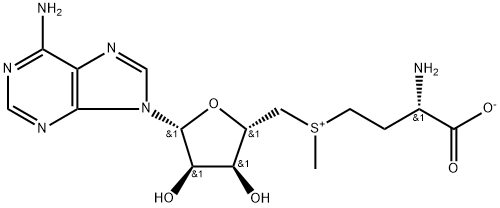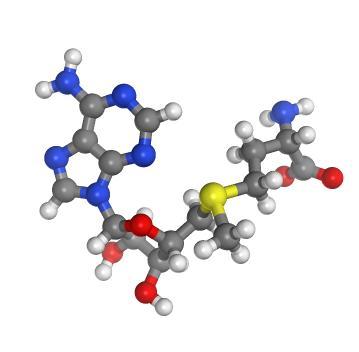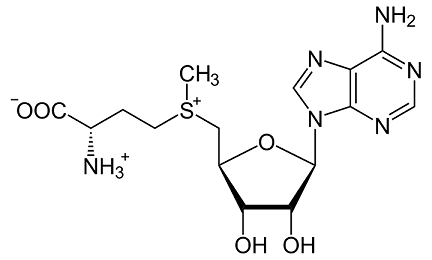S-Adenosyl-L-methionine: A Multi-Faceted Compound in Liver Health and Clinical Application
General Description
S-Adenosyl-L-methionine plays a crucial role in transmethylation and transsulfuration pathways, especially in the liver. It has demonstrated a preventive effect in liver disease and protects against intrahepatic cholestasis induced by various compounds. S-Adenosyl-L-methionine also distributes to the brain and stimulates dopaminergic and serotonergic pathways, potentially regulating mood. However, it has limited bioavailability after oral administration, with low peak plasma concentrations achieved. S-Adenosyl-L-methionine has shown promise in liver dysfunction, affective disorders, and other conditions, but further research is needed to establish its effectiveness and safety in these various clinical applications.

Figure 1. Tablets of S-Adenosyl-L-methionine
Pharmacodynamic
S-Adenosyl-L-methionine plays a crucial role in transmethylation reactions and acts as a precursor of sulfur-containing compounds through the transsulfuration pathway, especially in the liver. In liver disease, both pathways are often impaired. Methionine metabolism decreases in cirrhosis, leading to reduced production of sulfur compounds and phosphatidylcholine. Additionally, levels of thiol compounds like glutathione and cysteine decrease in plasma. S-Adenosyl-L-methionine has been shown to protect against intrahepatic cholestasis induced by various compounds, including estrogen, in animal models. It increases enzyme activity, fluidity of liver plasma membranes, and maintains phospholipid activity in bile salt transport systems. S-Adenosyl-L-methionine has demonstrated a preventive effect in women with estrogen-induced cholestasis. Furthermore, S-Adenosyl-L-methionine prevents mortality induced by paracetamol and lead poisoning in animals. It helps maintain glutathione stores, preventing hepatotoxicity from these agents. S-Adenosyl-L-methionine also maintains or prevents depletion of glutathione levels, normalizes mitochondrial enzyme activity, and prevents fat deposition in the liver in animals subjected to chronic ethanol ingestion. S-Adenosyl-L-methionine distributes to the brain and stimulates dopaminergic and serotonergic pathways. It increases levels of S-Adenosyl-L-methionine, 5-hydroxy indoleacetic acid (5HIAA), and homovanillic acid in cerebrospinal fluid. Folate and S-Adenosyl-L-methionine pathways influence mood, with disruptions observed in depressed patients. S-Adenosyl-L-methionine administration restores ATP levels in erythrocytes, reduces blood viscosity, and improves cell shape and deformability. In conclusion, S-Adenosyl-L-methionine's pharmacodynamic effects involve its role in transmethylation reactions, sulfur compound synthesis, liver protection, prevention of cholestasis and hepatotoxicity, brain stimulation, and potential mood regulation. 1
Pharmacokinetic
S-Adenosyl-L-methionine has limited bioavailability after oral administration, with low peak plasma concentrations achieved due to significant first-pass effect and rapid metabolism in the liver. An enteric-coated tablet formulation shows dose-related peak plasma concentrations of 0.5 to 1 mg/L achieved 3 to 5 hours after single doses in the range of 400 to 1000mg. Intravenous administration of S-Adenosyl-L-methionine (100 and 500mg) yields volumes of distribution of 0.41 and 0.44 L/kg, respectively. Plasma protein binding is 5% or less. S-Adenosyl-L-methionine distributes to all body tissues based on their degree of vascularity and blood flow and crosses the blood-brain barrier with slow accumulation in the cerebrospinal fluid. S-Adenosyl-L-methionine follows the same metabolic pathways as endogenous compounds, namely transmethylation, transsulfuration, and decarboxylation. In healthy volunteers, 34% and 40% of unchanged drug appeared in urine by 24 hours after intravenous S-Adenosyl-L-methionine administration of 100 or 500mg, respectively. Oral administration of a 200mg dose of S-Adenosyl-L-methionine shows 15.5% urinary excretion in 48 hours and 23.5% fecal excretion at 72 hours. The half-life of S-Adenosyl-L-methionine in healthy volunteers is 80 to 100 minutes and 121 minutes in patients with chronic liver disease. 2
Clinical applications
S-Adenosyl-L-methionine has demonstrated clinical applications in various conditions. In patients with liver dysfunction, S-Adenosyl-L-methionine has been shown to normalize measures of liver function and reverse liver enzyme abnormalities associated with chronic liver disease, including cirrhosis and cholestasis. It has also shown promise in protecting against hepatic dysfunction caused by other drugs and improving metabolic disorders such as Gilbert's syndrome and porphyria cutanea tarda. S-Adenosyl-L-methionine has been used in patients with affective disorders, particularly depression, where it has consistently shown to elevate mood. In short-term trials, S-Adenosyl-L-methionine has been found to be at least as effective as other antidepressant drugs, demonstrating an onset of action within the first two weeks of treatment. S-Adenosyl-L-methionine has also been studied as an adjunct to other antidepressants, potentially reducing the time to treatment response, particularly in suicidal patients. Additionally, S-Adenosyl-L-methionine treatment has been well tolerated, making it beneficial for patients who experience adverse effects from tricyclic antidepressant therapy. S-Adenosyl-L-methionine has been investigated for use in other disorders such as Alzheimer's disease, epilepsy, migraine, and primary fibromyalgia. While isolated reports suggest potential benefits, these effects have not been adequately studied in well-designed trials to draw definitive conclusions regarding efficacy. Overall, S-Adenosyl-L-methionine has shown promise in liver dysfunction, affective disorders, and other conditions, but further research is needed to establish its effectiveness and safety in these various clinical applications. 3
Reference
1. Friedel HA, Goa KL, Benfield P. S-adenosyl-L-methionine. A review of its pharmacological properties and therapeutic potential in liver dysfunction and affective disorders in relation to its physiological role in cell metabolism. Drugs. 1989 Sep;38(3):389-416.
2. Osman E, Owen JS, Burroughs AK. Review article: S-adenosyl-L-methionine--a new therapeutic agent in liver disease? Aliment Pharmacol Ther. 1993 Feb;7(1):21-8.
3. Li J, Sun C, Cai W, Li J, Rosen BP, Chen J. Insights into S-adenosyl-l-methionine (SAM)-dependent methyltransferase related diseases and genetic polymorphisms. Mutat Res Rev Mutat Res. 2021 Jul-Dec;788:108396.
Related articles And Qustion
Lastest Price from S-Adenosyl-L-methionine manufacturers

US $1.00-4.00/KG2025-09-12
- CAS:
- 29908-03-0
- Min. Order:
- 1KG
- Purity:
- 99%
- Supply Ability:
- 200000KG

US $0.00/Kg/Bag2025-04-21
- CAS:
- 29908-03-0
- Min. Order:
- 1KG
- Purity:
- 95%-105%
- Supply Ability:
- 100KGS





